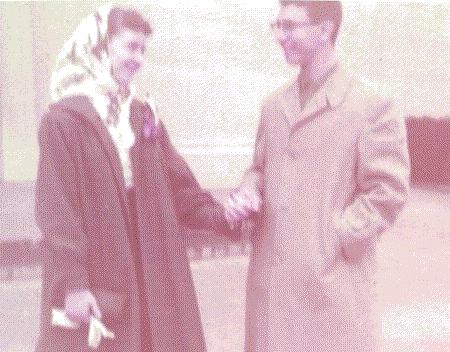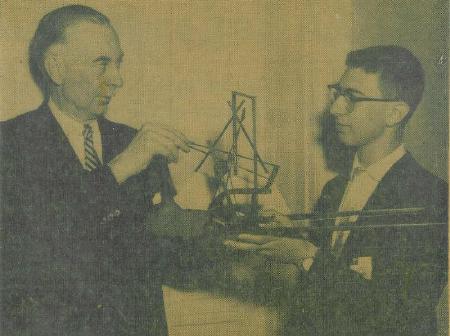Stories
The story of
the Stevenson family
I graduated from high school in the "year of the Sputnik". The United States reacted to the Russian satellite by demanding my generation to become scientists in order to "beat the Russians."
Because my test scores on the college entrance exams were among the highest in the nation, I was able to win various contests and scholarships. Most important, I was one of the finalists in the National Science Talent Search (STS).
From a wire service release in 1957. NEOSHO BOY IN VIST - Following in illustrious footsteps, David Adams, 17, of Neosho, Mo., pays a visit to the Smithsonian Institute, Washington, D.C., where the institute's secretary, Dr. Leonard Carmicael, shows him a model of the reaper patented in 1834 by one of David's ancestors, Cyrus Hall McCormick. The son of Robert McCormick Adams, David is one of the nation's 40 top teen-age scientists attending the tenth annual Science Talent Institute and competing for Westinghouse Science scholarships. A promising young paleontologist, he submitted several specimens from his fossil collection for consideration as additions to the Smithsonian's collection.
* * *
I had already one a local science fair in Pittsburg, Kansas, with a study and display on protozoa a few years before. For STS, I did "A Story from a Rock" with hundreds of fossils taken from a single rock on the hillside behind our house.
Between my high test scores and the excellent project, I was one of the 40 finalists who went to Washington in the spring of 1957. And the high point was falling in love with another finalist, Vee Schlatter, from a small town in Northwest Ohio. We shared the great excitement of the days of the finalists in Washington, and of first love. The first of my sonnets was written for her.

With Vee in Washington
Washington and Vee were the first big change in my life. I won scholarships to go whereever I wanted and after a trip to Harvard where the interviewer impressed me as an intellectual snob, I decided to go to New York (like my hero, the novelist Thomas Wolfe) and Columbia College. I took a trip to visit Vee in her hometown, carrying with me on the plane a jar of black widow spiders for her science project on the poisonous spider venom. It was all too much for me to handle and I tried to kill myself.
Despite my later concerns about the misuse of science, I retain always my commitment to use of the scientific method. Like Solomon and like Gandhi I have always tried to pursue the "truth," as best I can. In the 1970's I worked in the traditional sciences and in the 1980's I tried to approach the questions of peace using the scientific method. I came to adopt a vision of the scientific method as the use of repeatable techniques to obtain quantifiable data which were then published so that they could be verified by other scientists. For me the emphasis was on science as a form of communication, like a language, that could be universally understood and repeated. Its transparency and honesty was similar to the values that I later attributed to the culture of peace. Lack of transparency and honesty when I encountered it in the scientific establishment seemed to me to contradict the very nature of science itself.
 |
Stages
1986-1992
Fall of the Soviet Empire
1992-1997
UNESCO Culture of Peace Programme
